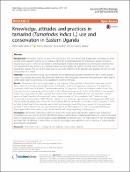| dc.contributor.author | Ebifa-Othieno, Esther | |
| dc.contributor.author | Mugisha, Antony | |
| dc.contributor.author | Nyeko, Philip | |
| dc.contributor.author | Kabasa, John David | |
| dc.date.accessioned | 2022-02-10T12:17:50Z | |
| dc.date.available | 2022-02-10T12:17:50Z | |
| dc.date.issued | 2017-01-21 | |
| dc.identifier.citation | Ebifa-Othieno, E... et al(2017). Knowledge, attitudes and practices in tamarind (Tamarindus indica L.) use and conservation in Eastern Uganda. J Ethnobiology Ethnomedicine 13, 5 (2017). https://doi.org/10.1186/s13002-016-0133-8 | en_US |
| dc.identifier.issn | 1746-4269 | |
| dc.identifier.uri | https://doi.org/10.1186/s13002-016-0133-8 | |
| dc.identifier.uri | https://kyuspace.kyu.ac.ug/xmlui/handle/20.500.12504/477 | |
| dc.description.abstract | Tamarindus indica L. is one of the indigenous fruit tree species that traditionally contributes to food security and ecosystem stability in sub-Saharan Africa. We hypothesized that the indigenous people of Eastern Uganda have used T. indica for generations and developed practices that promote its conservation and therefore we expected that they possess an elaborate indigenous knowledge (IK) system and that most of them have planted the species. The aim of this study was to assess the influence of IK, attitudes and practices on the use and conservation of T. indica.
Methods
A cross sectional survey was conducted in two districts purposively selected from the T. indica natural range. Focus group discussions, key informant interviews, semi-structured interviews and observation were used to collect data. Data was processed using qualitative analytical methods.
Results
Tamarindus indica was highly valued by the majority of the population. Tamarindus indica was used for food, medicinal, cultural, social, environmental amelioration and income generation purposes. The population possessed a high level of IK about T. indica evidenced by 18 categories of uses and multiple modes of use. Fruit pulp was the most commonly used tamarind product. Relative frequency of citation of the different uses provides insight into usage levels and IK possessed. The communities’ food and medicinal uses concurred with scientific reports of health benefits of consuming T. indica. Approximately half of respondents had T. indica on their compounds or homegardens (53%). Fifty two percent of the tamarind population was self-propagated, 45% were planted while the propagation history for the remaining 3% was not known. Constraints towards planting T. indica included limited land, long maturation period and low monetary value. Fifty three percent of those who were growing T. indica did not carry out any silvicultural practices. The majority of T. indica encountered (87%) was intercropped with other crops or trees. Several beliefs and taboos regarding T. indica persist.
Conclusion
Tamarindus indica has a high use value in the study area evidenced by multiple uses. Indigenous knowledge and uses concurred with scientifically proven nutritional and medicinal attributes of T. indica in literature which is significant given current trends towards affordable functional foods. The high level of IK has not translated into high rates of planting T. indica. There is need to encourage value-addition so as to maximize T. indica benefits and enhance conservation. | en_US |
| dc.language.iso | en | en_US |
| dc.publisher | Springer Nature: Journal of Ethnobiology and Ethnomedicine. | en_US |
| dc.subject | Tamarindus indica L. | en_US |
| dc.subject | Eastern Uganda | en_US |
| dc.title | Knowledge, attitudes and practices in tamarind (Tamarindus indica L.) use and conservation in Eastern Uganda | en_US |
| dc.type | Article | en_US |

